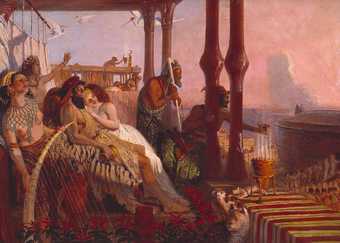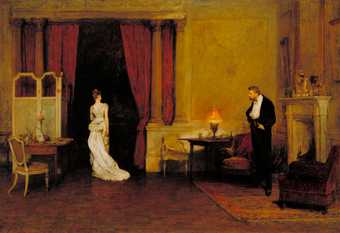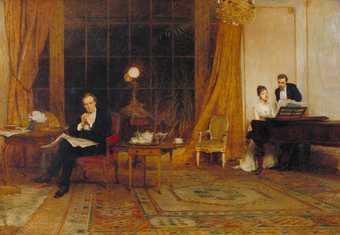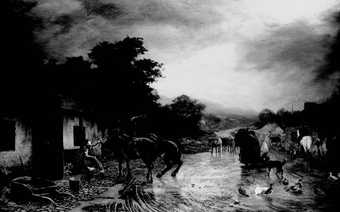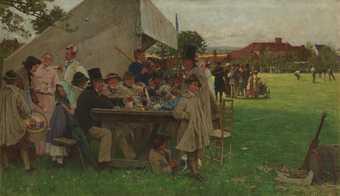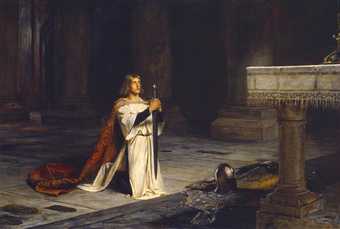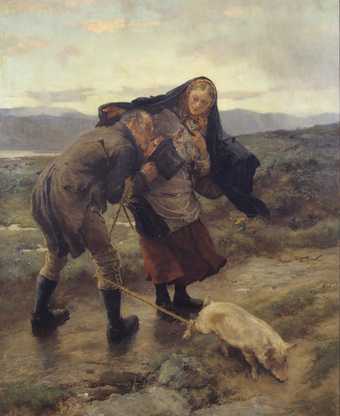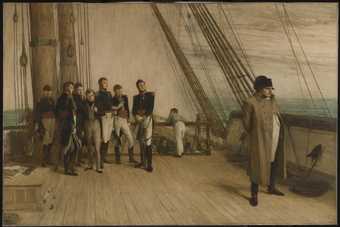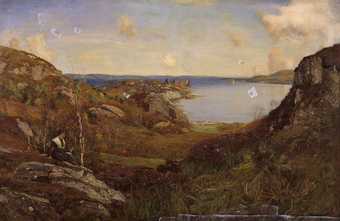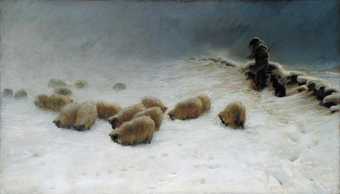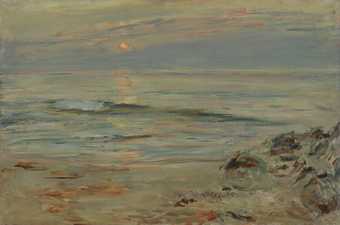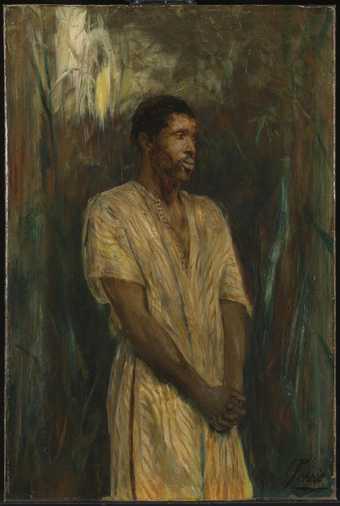
Not on display
- Artist
- William McTaggart 1835–1910
- Medium
- Oil paint on canvas
- Dimensions
- Support: 946 × 1410 mm
frame: 1365 × 1823 × 152 mm - Collection
- Tate
- Acquisition
- Purchased 1931
- Reference
- N04610
Summary
The full title of this work is Emigrants Leaving the Hebrides and it is the first of three major works by McTaggart on the subject of emigration. The other two are The Emigrants - America (1891-4, Miss Flure Grossart) and The Sailing of the Emigrant Ship (1895, National Gallery of Scotland), and, as with the Tate picture, there are replicas and variants of both.
McTaggart's sister, Barbara, and her husband were among the vast number of people who emigrated from the West Coast of Scotland to America and Canada in the mid-nineteenth century. The theme of emigration was at the back of McTaggart's mind from the time of the painting's conception in 1883. In this year he painted the headland, at Carrdale, in Argyllshire, from which the emigrants were to leave, as a straightforward landscape. In the same year an account of the Highland Clearances, collected and compiled by Alexander Mackenzie, was published; and the Crofter's Commission was appointed to look into individual cases of eviction. It was therefore amid debates about land ownership and emigration that McTaggart conceived the theme for this picture. Nevertheless the emigrants were not added to the painting until towards the end of the decade. They are shown rowing out from a lonely stretch of coast to meet a three-masted, square-rigged sailing ship. As Lindsay Errington has pointed out, it is far more likely that at this date they would have departed by steamer from the Clyde and therefore McTaggart's treatment is retrospective and historicised.
Probably the most distinctive feature of this work is McTaggart's handling of paint. In 1883 he may have seen the Impressionist exhibition staged by Durand-Ruel at Dowdeswell's Gallery in Bond Street; and certainly from this date onwards he began painting even his largest canvases out of doors. Rather like those in an Impressionist painting, the figures in the foreground are absorbed by the surrounding landscape. However, in this work McTaggart's broad handling, his use of the palette knife and the sense of the approaching storm are much closer to Constable than to the work of Monet. In order to give the picture a sense of movement he copies Constable's method of applying flickering white highlights to all parts of the canvas. Like Constable, he varies his brushstrokes, in order to capture the different textures of sky, sea and land. He also uses a buff priming, which appears patchily in the darker areas of the sky.
McTaggart painted a small replica of this image in 1891 (private collection) and reworked it in 1891-8 (Kirkcaldy Museum and Art Gallery). The later work is more loosely handled and 'impressionistic' than this first version. In the right foreground a box bears the letters 'AMERICA'; and on the far right a rainbow symbolises the emigrants' optimism as they travel to a new life.
Further reading:
Lindsay Errington, William McTaggart 1835-1910, Edinburgh 1989, pp.105-9.
Frances Fowle
December 2000
Does this text contain inaccurate information or language that you feel we should improve or change? We would like to hear from you.
Display caption
When McTaggart finished his training at the Trustees’ Academy in Edinburgh, he practised as a portrait painter with a minutely realistic technique. He became more interested in painting figures in landscape, and by the 1880s his handling of paint was much broader. He painted the sea and coastline, in works that are reminiscent of Courbet. The series of ‘emigrants’ that he painted combine these interests with a subject of serious social concern in Scotland, the emigration of people from the West Coast to live in Canada and Australia. McTaggart had first-hand experience of such emigration in his own family.
Gallery label, November 2016
Does this text contain inaccurate information or language that you feel we should improve or change? We would like to hear from you.
Explore
- history(5,776)
- child(1,324)
- UK countries and regions(24,355)
-
- Scotland(2,977)
- displacement(24)
- migration(20)
- boat - non-specific(2,203)
You might like
-
William Bell Scott The Eve of the Deluge
1865 -
Sir William Quiller Orchardson Her First Dance
1884 -
Sir William Quiller Orchardson The First Cloud
1887 -
Sir William Quiller Orchardson Her Mother’s Voice
exhibited 1888 -
Peter Graham A Rainy Day
1871 -
John Robertson Reid A Country Cricket Match
1878 -
John Pettie The Vigil
exhibited 1884 -
William Small The Last Match
1887 -
Sir William Quiller Orchardson Napoleon on Board the Bellerophon
exhibited 1880 -
Sir David Murray My Love has Gone a-Sailing
exhibited 1883 -
Joseph Farquharson The Joyless Winter Day
exhibited 1883 -
William McTaggart The Harvest Moon
c.1899 -
William McTaggart Summer Sundown - Tir-nan-og
1880 -
Edward Arthur Walton Berwickshire Field-workers
1884 -
John Pettie On the Dark Continent
exhibited 1890

